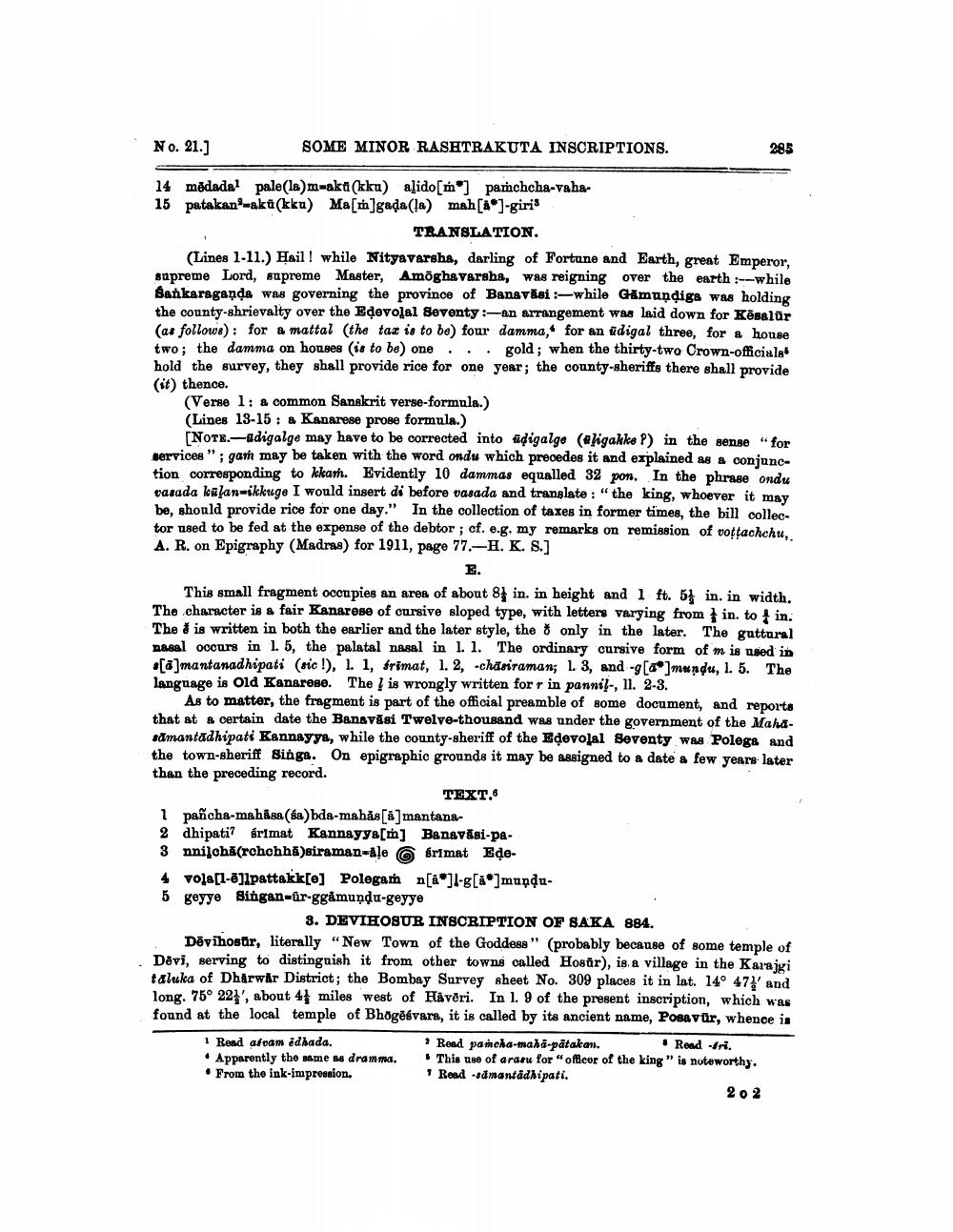________________
No. 21.]
14 modada pale (la) m-aku (kku) alido[m] pamchcha-vaha
15 patakan-aku(kku) Ma[m]gada (la) mah [*]-giri3
TRANSLATION.
SOME MINOR RASHTRAKUTA INSCRIPTIONS.
(Lines 1-11.) Hail! while Nityavarsha, darling of Fortune and Earth, great Emperor, supreme Lord, supreme Master, Amoghavarsha, was reigning over the earth :--while Sankaraganda was governing the province of Banavasi :-while Gamuṇḍiga was holding the county-shrievalty over the Edevolal Seventy:-an arrangement was laid down for Kesalur (as follows): for a mattal (the tax is to be) four damma, for an udigal three, for a house two; the damma on houses (is to be) one... gold; when the thirty-two Crown-officials hold the survey, they shall provide rice for one year; the county-sheriffs there shall provide (it) thence.
(Verse 1: a common Sanskrit verse-formula.) (Lines 13-15: a Kanarese prose formula.)
"for
[NOTE.-adigalge may have to be corrected into adigalge (aligakke P) in the sense services"; gam may be taken with the word ondu which precedes it and explained as a conjunction corresponding to kkam. Evidently 10 dammas equalled 32 pon. In the phrase ondu vasada kalan-ikkuge I would insert di before vasada and translate: "the king, whoever it may be, should provide rice for one day." In the collection of taxes in former times, the bill collector used to be fed at the expense of the debtor; cf. e.g. my remarks on remission of votṭachchu, A. R. on Epigraphy (Madras) for 1911, page 77.-H. K. S.]
E.
This small fragment occupies an area of about 8 in. in height and 1 ft. 5 in. in width. The character is a fair Kanarese of cursive sloped type, with letters varying from in. to in. The is written in both the earlier and the later style, the only in the later. The guttural nasal occurs in 1. 5, the palatal nasal in 1. 1. The ordinary cursive form of m is used in [a]mantanadhipati (sic!), 1. 1, frimat, 1. 2, -chasiraman; 1. 3, and -g[a]mundu, 1. 5. The language is Old Kanarese. The is wrongly written for r in pannil-, 11. 2-3.
As to matter, the fragment is part of the official preamble of some document, and reports that at a certain date the Banavasi Twelve-thousand was under the government of the Mahasamantadhipati Kannayya, while the county-sheriff of the Edevolal Seventy was Polega and the town-sheriff Singa. On epigraphic grounds it may be assigned to a date a few years later than the preceding record.
TEXT.6
1 pañcha-mahasa (sa)bda-mahās[a]mantana
2 dhipati srimat Kannayya[m] Banavasi-pa
3 nnilcha(rchchha)siraman-ale frimat Eḍe
285
4 vola[1-8]lpattakk[e] Polegam n[*]l-g[*]mundu
5 geyye Singan-ür-ggåmundu-geyye
1 Read afvam edhada. Apparently the same as dramma. From the ink-impression.
3. DEVIHOSUR INSCRIPTION OF SAKA 884.
Devihosür, literally "New Town of the Goddess" (probably because of some temple of Devi, serving to distinguish it from other towns called Hosar), is a village in the Karajgi taluka of Dharwar District; the Bombay Survey sheet No. 309 places it in lat. 14° 47' and long. 75° 22, about 4 miles west of Haveri. In 1. 9 of the present inscription, which was found at the local temple of Bhōgesvara, it is called by its ancient name, Posavür, whence is
Read pamoka-mahā-pātakan.
Read -fri. This use of arasu for "officer of the king" is noteworthy. Read -samantadhipati.
202




